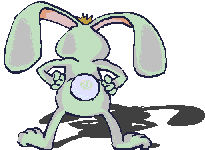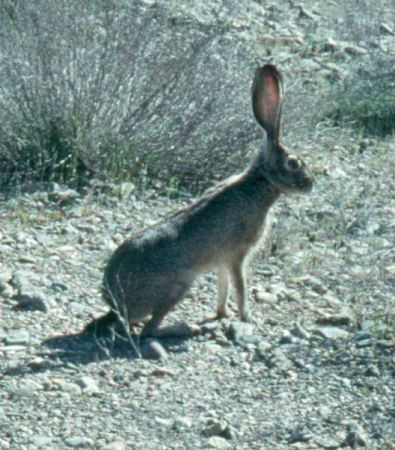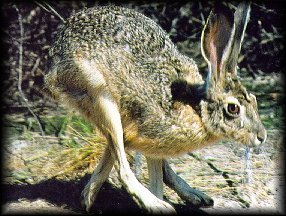|
|
Canku Ota |
|
|
(Many Paths) |
||
|
An Online Newsletter Celebrating Native America |
||
|
September 7, 2002 - Issue 69 |
||
|
|
||
|
How to Scare a Bear |
||
|
Tewa Legend
|
||
|
|
 Long
ago and far away this did not happen. On top of Red Rock Hill, lived a
little rabbit. Prickly pears were his favorite food, and every day he
would hunt for them along the east bank of the Rio Grande. Eventually
he ate all the prickly pears on that bank, so he cast his hungry eyes
across the river. He said to himself, "I'll bet plenty of them grow
over there. Now, how am I going to get across the river to look?" Long
ago and far away this did not happen. On top of Red Rock Hill, lived a
little rabbit. Prickly pears were his favorite food, and every day he
would hunt for them along the east bank of the Rio Grande. Eventually
he ate all the prickly pears on that bank, so he cast his hungry eyes
across the river. He said to himself, "I'll bet plenty of them grow
over there. Now, how am I going to get across the river to look?"
The rabbit knew the river was too deep and too wide for him to swim on his own, and he sighed, "Oh, how I wish that Uncle Fast Water, who moves the current, were here to take me across." Fast Water heard and replied, "Child, I'm lying right here. What can I do for you?" The little rabbit leaped toward the sound, "Uncle, so this is where you live!" "Yes, this is the place," said his uncle. "What kind of work do you want from me?" "I want to cross the river to pick prickly pears, but the water is too deep and too wide for me. Will you help me get across?" Fast Water agreed, so the little rabbit sat on top of his head. "Splash! Splash! Splash!" went the water, and quickly the two were on the other side. "Be sure and call me when you want to come back," Fast Water said when they landed. The rabbit wanted to get home before night fell, so he wasted no time but went right to picking and eating prickly pears.
"Yes, Brother Bear?" "My! What a pretty necklace you have." "Yes, isn't it?" I want to make a bet with you for that necklace," said Brother Bear. "I'm willing to bet my red necklace for yours. If I win, you'll give me yours, and if you win, I'll give you mine." Little rabbit agreed, and they arranged to meet at noon the next day in the same spot. That afternoon the little rabbit returned to the river, and his uncle easily carried him back across the water. "Tomorrow you must wait for me, Uncle. I have placed a bet with Brother Bear, and I'll need you to carry me across the river again!" I'll wait for you," replied his uncle. "I know you'll win."
When noon came, Brother Bear appeared. "You're here early," he said. "Yes," answered the little rabbit, but he said nothing more. The two picked a place in the dense wooded area to have their contest. Then Brother Bear made a circle on the ground with a stick. "Little Rabbit, you can go first," said Brother Bear. "Oh, no," said the little rabbit. "You wanted to bet, and you should go first." "Yes, I'll go first. I'll bet you I'm the braver of us two. See that circle? You sit in it, and if you move even a little from where you're sitting I win." Little Rabbit said down, and Brother Bear took off into the woods. A few minutes later the rabbit heard strange sounds: Aaah...Aaaah...Aaah.. Aaah...Aaaah...Aaah.. "I know that's Brother Bear," thought the little rabbit. "He's trying to scare me, but I won't move. Closer and closer came the strange sounds. Suddenly, with a crash a great big tree came tumbling down and barely missed the little rabbit.
"No, I don't move. Come and see for yourself," answered the rabbit. Brother bear couldn't find any foot marks and had to agree that the little rabbit had not moved at all. Little Rabbit said to Brother Bear, "Now you must sit in this circle as I did in yours." The rabbit drew a circle, and Brother Bear sat in it. Leaving Brother Bear sitting in the circle, the rabbit headed into the woods. He just put the old horse bell around his neck and headed toward the place where Brother Bear was waiting. After he had hopped a few steps, the little rabbit stopped, rang the horse bell, and sang: Ah nana-na--------Ah nana-na------ When Brother Bear head this, he thought, "That's not my friend Little Rabbit. This is something else altogether." Coming closer to the circle where Brother Bear was sitting, the little rabbit rang his horse bell louder and sang his song once more. Brother Bear, growing really frightened, stood up and ran. The little rabbit jumped out and called, "You've lost! Let me have your necklace!"
--Translated from the Tewa by Alfonso Ortiz Print and Color Your Own Jackrabbit |
|
|
|
Black-tailed Jackrabbit
(Lepus californicus)
|
|
Physical Characteristics: Mass: 1 to 3 kg. Our largest hare, black-tailed jackrabbits measure about 47-63 cm from nose to rump, the tail is between 50-112 mm and the ears are 10-13 cm long. As it is a true hare, the black-tailed jackrabbit is lankier and leaner than a rabbit, has longer ears and legs, and its leverets are born fully-furred and open-eyed. The black-tailed jackrabbit posses a characteristic black stripe down the center of its back, a black rump patch, and its tail is black dorsally. Both sexes look alike, but the female is the larger of the two sexes. Natural History Reproduction Behavior Habitat Biomes: temperate grassland, chaparral, desert
Negative Conservation Status: no special status Populations of black-tailed jackrabbits are quite high despite ranchers' and farmers' attempts at culling their populations through herding and slaughter. Large herding attempts have netted as much as 20,000 hares at a time, and population densities often reach 100 animals per square km. As with many hares, Lepus californicus populations undergo drastic fluctuations in regular cycles every 9-10 years. Populations increase to great abundance and then suddenly decline for unknown reasons. In some years more then 90 per cent of the western populations die from tularemia, which may or may not be related to the population cycling phenomenon. Because of their incredible fecundity, blacktail numbers quickly recover, however. Other Comments |
|
|
||
|
|
||
| Canku Ota is a free Newsletter celebrating Native America, its traditions and accomplishments . We do not provide subscriber or visitor names to anyone. Some articles presented in Canku Ota may contain copyright material. We have received appropriate permissions for republishing any articles. Material appearing here is distributed without profit or monetary gain to those who have expressed an interest. This is in accordance with Title 17 U.S.C. section 107. | ||
|
Canku Ota is a copyright © 2000, 2001, 2002 of Vicki Lockard and Paul Barry. |
||
 |
 |
|
|
The "Canku Ota - A Newsletter Celebrating Native America" web site and its design is the |
||
|
Copyright © 1999, 2000, 2001, 2002 of Paul C. Barry. |
||
|
All Rights Reserved. |
||
 Then
Brother Bear appeared. "Little Rabbit!"
Then
Brother Bear appeared. "Little Rabbit!" The
next day the little rabbit got up early and hurried to meet Brother
Bear. Because of his early start, he arrived first and decided to stroll
in the woods. As he was hopping around, he spotted an old horse bell
that still had a dried-up piece of leather tied to it. He hung it around
his neck, and with each jump the bell went "Clank! Clank!"
The little rabbit said to himself, "I think this bell will come
in very handy with Brother Bear." And he hid the bell carefully
in the woods.
The
next day the little rabbit got up early and hurried to meet Brother
Bear. Because of his early start, he arrived first and decided to stroll
in the woods. As he was hopping around, he spotted an old horse bell
that still had a dried-up piece of leather tied to it. He hung it around
his neck, and with each jump the bell went "Clank! Clank!"
The little rabbit said to himself, "I think this bell will come
in very handy with Brother Bear." And he hid the bell carefully
in the woods. As
the story goes, the little rabbit defeated the Brother Bear. And today
if you see a rabbit around Tewa country, and if he has a red ring around
his neck, you can be sure that the rabbit is descended from the little
rabbit who won Brother Bear's pretty red necklace.
As
the story goes, the little rabbit defeated the Brother Bear. And today
if you see a rabbit around Tewa country, and if he has a red ring around
his neck, you can be sure that the rabbit is descended from the little
rabbit who won Brother Bear's pretty red necklace. Geographic
Range
Geographic
Range Economic
Importance for Humans
Economic
Importance for Humans